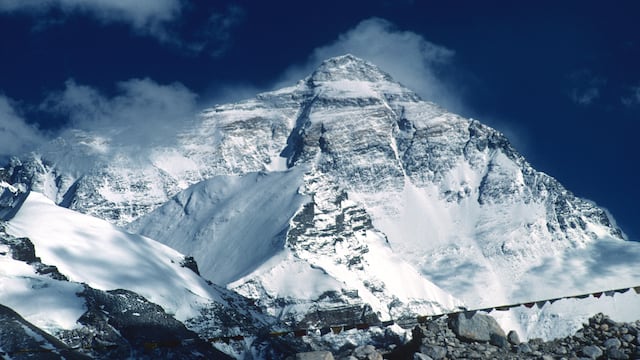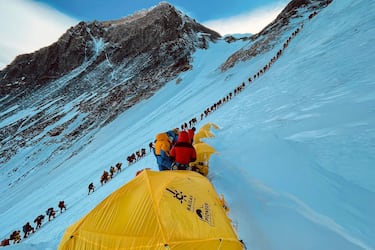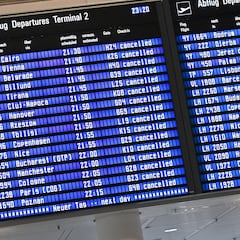Mount Everest faces rising deaths, trash, and Sherpa exploitation as Nepal enacts reforms to curb over-tourism by reducing fees on other peaks.

The huge cost of climbing Everest — and nearby mountains you can now explore for “free”

It’s no secret that Mount Everest has become something of a hellscape. Currently hundreds of climbers are trapped on the mountain and waiting to be rescued.
❄️ Hundreds of trekkers trapped by a blizzard near Mount Everest’s eastern face in Tibet have been rescued.
— Volcaholic 🌋 (@volcaholic1) October 6, 2025
Around 350 reached Qudang township, and contact has been made with over 200 others after heavy snow and rain hit the Himalayas.pic.twitter.com/9qiLNWKc56
The mountain is strewn with trash left behind by climbers, and the perilous conditions faced by Sherpas—who guide an increasingly inexperienced class of adventurers to the summit—continue to make headlines. Sherpas risk their lives in the process, revealing an exploitative industry dominated by wealth that prioritizes profits over safety and environmental stewardship. The New York Times reported in 2023 on the mass exodus of sherpas from the sector, highlighting the “scant security [the profession] it offers.” “If a guide becomes disabled or ends up dead, there is little safety net for his family — insurance payouts are limited, and a promised government welfare fund for Sherpa guides has not materialized," explained Bhadra Sharmaand and Mujib Mashal in their alarming piece on the state of affairs for these mountaineering experts.
Also in 2023, the BBC reported that after an especially deadly climbing season, authorities were considering stricter requirements for climbing permits. That spring, 12 fatalities were recorded—the highest number since 2019, when 11 deaths occurred. Nevertheless, in Nepal, where roughly one-fifth of the population lives below the poverty line, economic dependence on Everest has grown in recent years. Estimates suggest that between six and ten percent of the country’s GDP is tied to the industry surrounding the world’s tallest peak, and political leaders have rejected responsibility for the dangers and insecurity facing those who make the industry possible.
In 2024, Nepal’s Supreme Court ordered the government to limit the number of permits issued, to reduce “traffic” on the mountain.

Though such action has not been taken, the parliament has implemented a series of new rules aimed at curtailing visits to Everest, while continuing to encourage tourism.
What actions has the government taken?
A law was passed in January to increase permit fees. These are the costs effective September 1, 2025:
- Peak Season | April and May: $15,000
- September to November: $7,500
- December to January: $3,500
The increase from $11,000 for peak season represents a 36 percent rise in cost, which the government hopes will allow for better upkeep. However, the few thousand-dollar difference may not be enough to keep wealthy, inexperienced hikers off the trail.
Following the increase in permit prices, the country also passed a law that will require those seeking to climb Everest to have scaled another mountain in Nepal of at least 7,000 meters. This additional requirement aims to boost tourism, while also ensuring that a hiker seeking a permit for Everest has a better understanding of what they are signing up for.
Finally, earlier this month, Nepal’s parliament passed a law eliminating the royalty fee on nearly 100 other mountains, many of which are located in the remote western region—an area which remains poorly connected to the capital, Kathmandu.
According to Swotah, an expedition company based in Nepal, three mountains that will see fees eliminated that reach the 7,000m level requirement to scale Everest include Saipal (7,030 m), known for its “striking pyramid-shaped peak” and gorgeous views, Api (7,132 m), which happens to be the “highest peak in the far west, surrounded by dramatic ridges and glaciers,” and Api West (7,076 m), situated very close to Api, and is considering more challenging to climb, bringing with it the benefit that it is trafficed by fewer hikers.
The trekking community remains divided
While these peaks are less accessible, the move to lower fees aligns with the broader effort to tighten regulations on Everest and encourage climbers to explore alternative routes. However, as ExplorersWeb, an outdoor adventure outlet, explained, the royalty fee is just one of many costs travelers face when applying for a climbing permit in Nepal. The outlet also highlights existing laws that prohibit tourists from applying for these permits directly, instead requiring that they use an expedition agency, which will set its price for its services.
Though few within the extreme hiking community would argue that Everest doesn’t face serious challenges, not everyone is convinced that these legal changes address the root causes of the mountain’s over-tourism in recent years. ExplorersWeb notes that between 2008 and 2018, similar initiatives were tested but failed to generate a significant increase in visits. Citing data from The Himalayan Times, the outlet reported that between 2023 and 2025, only 68 climbers visited Saipal, Api, and Api West—attributing the low interest to “the region’s lack of infrastructure and poor connections to Kathmandu.”
The remote nature of these mountains also means that reducing the royalty fee will not substantially affect the overall cost of an expedition, argues ExplorersWeb, which spoke with Mick Fowler, an award-winning climber with extensive knowledge of the regions the government hopes to promote. “The peak fee is a very small percentage of the cost of an expedition to western Nepal,” Fowler explained, adding that he does not believe the government’s efforts will significantly change the landscape.
Related stories
Get your game on! Whether you’re into NFL touchdowns, NBA buzzer-beaters, world-class soccer goals, or MLB home runs, our app has it all.
Dive into live coverage, expert insights, breaking news, exclusive videos, and more – plus, stay updated on the latest in current affairs and entertainment. Download now for all-access coverage, right at your fingertips – anytime, anywhere.


Complete your personal details to comment